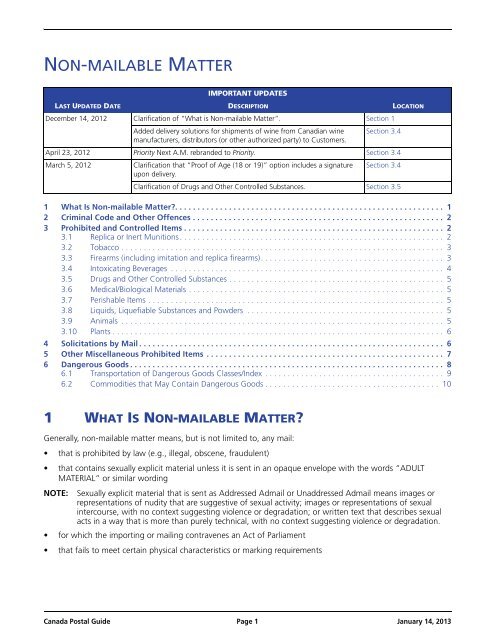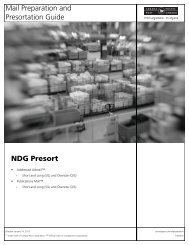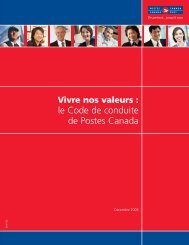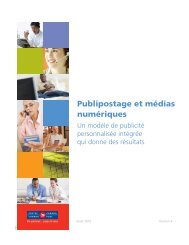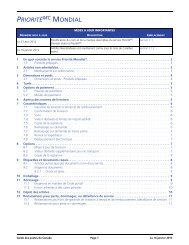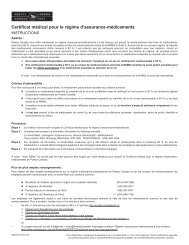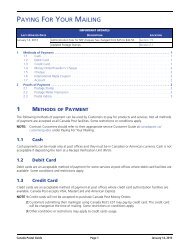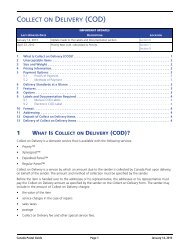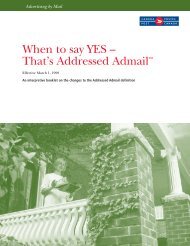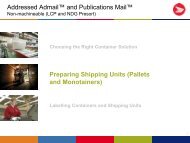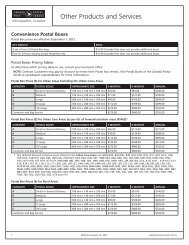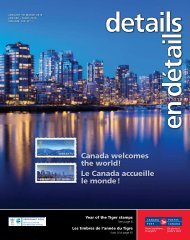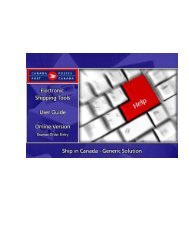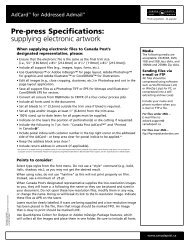NON-MAILABLE MATTER - Canada Post
NON-MAILABLE MATTER - Canada Post
NON-MAILABLE MATTER - Canada Post
Create successful ePaper yourself
Turn your PDF publications into a flip-book with our unique Google optimized e-Paper software.
<strong>NON</strong>-<strong>MAILABLE</strong> <strong>MATTER</strong><br />
IMPORTANT UPDATES<br />
LAST UPDATED DATE DESCRIPTION LOCATION<br />
December 14, 2012 Clarification of “What is Non-mailable Matter”. Section 1<br />
Added delivery solutions for shipments of wine from Canadian wine<br />
manufacturers, distributors (or other authorized party) to Customers.<br />
Section 3.4<br />
April 23, 2012 Priority Next A.M. rebranded to Priority. Section 3.4<br />
March 5, 2012 Clarification that “Proof of Age (18 or 19)” option includes a signature<br />
upon delivery.<br />
Section 3.4<br />
Clarification of Drugs and Other Controlled Substances. Section 3.5<br />
1 What Is Non-mailable Matter?. . . . . . . . . . . . . . . . . . . . . . . . . . . . . . . . . . . . . . . . . . . . . . . . . . . . . . . . . . . . 1<br />
2 Criminal Code and Other Offences . . . . . . . . . . . . . . . . . . . . . . . . . . . . . . . . . . . . . . . . . . . . . . . . . . . . . . . . 2<br />
3 Prohibited and Controlled Items . . . . . . . . . . . . . . . . . . . . . . . . . . . . . . . . . . . . . . . . . . . . . . . . . . . . . . . . . . 2<br />
3.1 Replica or Inert Munitions . . . . . . . . . . . . . . . . . . . . . . . . . . . . . . . . . . . . . . . . . . . . . . . . . . . . . . . . . . . 2<br />
3.2 Tobacco . . . . . . . . . . . . . . . . . . . . . . . . . . . . . . . . . . . . . . . . . . . . . . . . . . . . . . . . . . . . . . . . . . . . . . . . 3<br />
3.3 Firearms (including imitation and replica firearms). . . . . . . . . . . . . . . . . . . . . . . . . . . . . . . . . . . . . . . . . 3<br />
3.4 Intoxicating Beverages . . . . . . . . . . . . . . . . . . . . . . . . . . . . . . . . . . . . . . . . . . . . . . . . . . . . . . . . . . . . . 4<br />
3.5 Drugs and Other Controlled Substances . . . . . . . . . . . . . . . . . . . . . . . . . . . . . . . . . . . . . . . . . . . . . . . . 5<br />
3.6 Medical/Biological Materials . . . . . . . . . . . . . . . . . . . . . . . . . . . . . . . . . . . . . . . . . . . . . . . . . . . . . . . . . 5<br />
3.7 Perishable Items . . . . . . . . . . . . . . . . . . . . . . . . . . . . . . . . . . . . . . . . . . . . . . . . . . . . . . . . . . . . . . . . . . 5<br />
3.8 Liquids, Liquefiable Substances and Powders . . . . . . . . . . . . . . . . . . . . . . . . . . . . . . . . . . . . . . . . . . . . 5<br />
3.9 Animals . . . . . . . . . . . . . . . . . . . . . . . . . . . . . . . . . . . . . . . . . . . . . . . . . . . . . . . . . . . . . . . . . . . . . . . . 5<br />
3.10 Plants . . . . . . . . . . . . . . . . . . . . . . . . . . . . . . . . . . . . . . . . . . . . . . . . . . . . . . . . . . . . . . . . . . . . . . . . . . 6<br />
4 Solicitations by Mail . . . . . . . . . . . . . . . . . . . . . . . . . . . . . . . . . . . . . . . . . . . . . . . . . . . . . . . . . . . . . . . . . . . . 6<br />
5 Other Miscellaneous Prohibited Items . . . . . . . . . . . . . . . . . . . . . . . . . . . . . . . . . . . . . . . . . . . . . . . . . . . . . 7<br />
6 Dangerous Goods . . . . . . . . . . . . . . . . . . . . . . . . . . . . . . . . . . . . . . . . . . . . . . . . . . . . . . . . . . . . . . . . . . . . . . 8<br />
6.1 Transportation of Dangerous Goods Classes/Index . . . . . . . . . . . . . . . . . . . . . . . . . . . . . . . . . . . . . . . . 9<br />
6.2 Commodities that May Contain Dangerous Goods . . . . . . . . . . . . . . . . . . . . . . . . . . . . . . . . . . . . . . . 10<br />
1 WHAT IS <strong>NON</strong>-<strong>MAILABLE</strong> <strong>MATTER</strong>?<br />
Generally, non-mailable matter means, but is not limited to, any mail:<br />
• that is prohibited by law (e.g., illegal, obscene, fraudulent)<br />
that contains sexually explicit material unless it is sent in an opaque envelope with the words “ADULT<br />
MATERIAL” or similar wording<br />
NOTE: Sexually explicit material that is sent as Addressed Admail or Unaddressed Admail means images or<br />
representations of nudity that are suggestive of sexual activity; images or representations of sexual<br />
intercourse, with no context suggesting violence or degradation; or written text that describes sexual<br />
acts in a way that is more than purely technical, with no context suggesting violence or degradation.<br />
for which the importing or mailing contravenes an Act of Parliament<br />
that fails to meet certain physical characteristics or marking requirements<br />
<strong>Canada</strong> <strong>Post</strong>al Guide Page 1 January 14, 2013
<strong>Canada</strong> <strong>Post</strong>al Guide – Non-mailable Matter<br />
that contains products or substances that could:<br />
cause injury to those handling the mail<br />
cause damage to postal equipment or other items, or<br />
cause entrapment of other items.<br />
Any item bearing a modified postage stamp in contravention of section 52, or bearing a word or mark in<br />
contravention of section 58, of the <strong>Canada</strong> <strong>Post</strong> Corporation Act and Regulations is also non-mailable matter.<br />
The Customer is solely responsible for ensuring that an item is acceptable for mailing. Without limiting that<br />
responsibility, by depositing an item with <strong>Canada</strong> <strong>Post</strong> the Customer represents to <strong>Canada</strong> <strong>Post</strong> that the item has<br />
been properly prepared and paid for, does not constitute non-mailable matter, and that the mailing of that item is<br />
permitted by applicable law. The Customer acknowledges that in accepting an item for deposit, <strong>Canada</strong> <strong>Post</strong> may<br />
expressly rely on that representation from the Customer. Visit General Terms and Conditions at canadapost.ca/<br />
generalterms for information on how non-compliant items will be handled. For more information, refer to the<br />
<strong>Canada</strong> <strong>Post</strong> Corporation Act and Regulations. See in particular the Non-mailable Matter Regulations and the<br />
Solicitations by Mail Regulations.<br />
2 CRIMINAL CODE AND OTHER OFFENCES<br />
Any person using the mail for the delivery of any one of the following items commits an offence:<br />
articles that are obscene, indecent, immoral or scurrilous<br />
any information relating to bookmaking, pool-setting, betting or waging<br />
articles relating to unlawful lottery schemes<br />
any article relating to schemes to deceive or defraud the public<br />
articles or special messages sent to any person with the intention to obtain money under false pretences.<br />
NOTE: False representation on any customs document is considered an offence.<br />
3 PROHIBITED AND CONTROLLED ITEMS<br />
Some products may be prohibited from the mail or prohibited from entering <strong>Canada</strong>. Prohibited products are not<br />
permitted in the mail under any circumstances.<br />
Controlled products may be permitted in the mail but have special requirements or require special<br />
documentation.<br />
The list that follows is a general overview of prohibited items, or items that may have special restrictions on how<br />
or to whom they may be shipped. These items must be properly prepared and meet applicable requirements for<br />
mailing.<br />
3.1 Replica or Inert Munitions<br />
Replica or inert munitions are non-mailable, as well as other devices that simulate explosive devices or munitions,<br />
including replica or inert grenades or other simulated military munitions, whether or not such items are for<br />
display purposes. These products are not permitted in the mail under any circumstances.<br />
Page 2 January 14, 2013
3.2 Tobacco<br />
<strong>Canada</strong> <strong>Post</strong>al Guide – Non-mailable Matter<br />
Tobacco products are non-mailable unless:<br />
the shipments are intra provincial (within province only)<br />
the shipment is between manufacturers and retailers or between retailers. These items can only be shipped<br />
by Customers using Electronic Shipping Tools (EST) and selecting the “PROOF OF AGE (18 or 19) option<br />
the product is a replacement product (free of charge) mailed by a manufacturer to a consumer<br />
the person is otherwise exempted by the regulations<br />
they are imported in limited quantities for personal consumption and meet the requirements of the <strong>Canada</strong><br />
Border Services Agency’s enforcement of the Tobacco Act.<br />
NOTE 1: A unit is defined as: 200 cigarettes; 50 cigars; 200 tobacco sticks; or 200 g (7 ounces) of manufactured<br />
tobacco. Amounts in excess of five units are subject to the labelling and stamping requirements of the<br />
Tobacco Department Regulations.<br />
2: The originator of the shipment is solely accountable to ensure all tobacco shipments meet the<br />
requirements defined within the Tobacco Act.<br />
For additional information, refer to the Stamping and Marking of Tobacco Products Regulations or the Tobacco<br />
Act on the Department of Justice website.<br />
3.3 Firearms (including imitation and replica firearms)<br />
Please contact the Canadian Firearms Centre at cfc-cafc.gc.ca or by calling 1.800.731.4000 to determine<br />
whether it is permissible to ship your firearms.<br />
When it is determined permissible to ship firearms, they must be shipped as follows:<br />
CUSTOMER TYPE SERVICE TO BE USED<br />
Non-contract Customer Regular Parcel with Signature option.<br />
Contract Customer Expedited Parcel with the Proof of Age (18 or 19) option using EST. Visit section 4.3.2<br />
Mail Addressed to Children of Policies for an age of majority by province or territory<br />
listing.<br />
There cannot be any ammunition in the firearm or in the package. Bullets, cartridges and other ammunition are<br />
dangerous goods and cannot be mailed. These items fall under Class 1 (Explosives) of the Canadian<br />
Transportation of Dangerous Goods Act and Regulations.<br />
Customers who wish to ship firearms must:<br />
unload the firearms<br />
attach a secure locking device to the firearms<br />
lock the firearms in a sturdy, non-transparent container, and<br />
remove the bolt or bolt carrier from any automatic firearms (if removable).<br />
Firearms cannot be shipped via air and cannot have any markings on the outside of the packaging. The Customer<br />
is solely responsible for meeting all Canadian Firearms Centre regulations.<br />
NOTE: For more packaging tips, refer to section 3.2.1 Suggestions for How to Package and Wrap Items of<br />
ABCs of Mailing.<br />
January 14, 2013 Page 3
<strong>Canada</strong> <strong>Post</strong>al Guide – Non-mailable Matter<br />
3.4 Intoxicating Beverages<br />
For information regarding the importing or mailing of intoxicating beverages, refer to the federal Importation of<br />
Intoxicating Liquors Act and contact the provincial liquor board. The Importation of Intoxicating Liquors Act can<br />
be found on the Department of Justice website.<br />
Intoxicating beverages can only be shipped within <strong>Canada</strong> when:<br />
a Provincial Liquor Board or Commission is mailing to a manufacturer, distributor or individual within the<br />
same province<br />
a manufacturer of such beverages is mailing to a Provincial Liquor Board or Commission, to a distributor of<br />
such beverages in <strong>Canada</strong>, or to an individual within the same province<br />
a distributor of such beverages is mailing to a Provincial Liquor Board or Commission, to a manufacturer or<br />
distributor of such beverages in <strong>Canada</strong>, or to an individual within the same province<br />
they are mailed between a peace officer and a test laboratory for the purpose of carrying out a lawful<br />
investigation.<br />
A party* mails wine** or arranges for wine to be mailed from one province*** to an individual in another<br />
province in accordance with the Importation of Intoxicating Liquors Act and the respective laws of the origin<br />
and destination provinces. Laws applicable to the shipment of wine vary by province. It is the Customer's sole<br />
responsibility to ensure:<br />
wine shipments comply with applicable provincial legislation; and<br />
recipient individuals are receiving the wine for their own personal consumption and not for resale or<br />
other commercial use.<br />
* Parties permitted to mail wine will vary by province in accordance with applicable provincial legislation.<br />
** As defined in the Importation of Intoxicating Liquors Act. Note that certain provinces have further restrictions on what is<br />
classified as 'wine'.<br />
*** As defined in the Importation of Intoxicating Liquors Act. This definition is only applicable to the mailing of wine as set out<br />
above.<br />
Regardless of who is shipping, special restrictions apply as follows:<br />
1. If the intoxicating beverage contains less than 24% alcohol by volume* (e.g. 48 proof), the item can be<br />
shipped by air or ground.<br />
2. If the intoxicating beverage contains:<br />
more than 24% alcohol by volume (e.g. 48 proof); and<br />
less than 70% alcohol by volume (e.g. 140 proof); and<br />
is shipped in a container of less than five (5) litres,<br />
the item can be shipped by ground only.<br />
* When shipping via Priority, intoxicating beverages are only acceptable if they contain less than 24% alcohol by volume.<br />
NOTE: Service is only available to Parcel Services contract Customers or VentureOne Customers using EST. The<br />
Customer must select the “PROOF OF AGE” (18 or 19) option (which includes a signature at delivery).<br />
Intoxicating beverages can only be imported into <strong>Canada</strong> by mail when:<br />
they are imported by or mailed to a licensed distiller or body authorized by the board, commission, officer or<br />
other governmental agency in the province of destination, and<br />
the alcohol content is no greater than 24% alcohol by volume (e.g. 48 proof).<br />
Intoxicating beverages can only be exported from <strong>Canada</strong> by mail if:<br />
the applicable requirements for export have been met and the international destination postal administration<br />
permits such mailings (see canadapost.ca/internationallistings for more information).<br />
Page 4 January 14, 2013
3.5 Drugs and Other Controlled Substances<br />
<strong>Canada</strong> <strong>Post</strong>al Guide – Non-mailable Matter<br />
Drugs, including narcotics and other controlled substances are governed by the Controlled Drugs and Substances<br />
Act and the Food and Drugs Act and can only be mailed in certain circumstances and subject to various<br />
restrictions. For information on Marihuana Medical Access Requlations visit the Department of Justice website at<br />
http://laws-lois.justice.gc.ca/eng/regulations/SOR-2001-227/page-8.html#docCont.<br />
3.6 Medical/Biological Materials<br />
The material must not be infectious, poisonous, or otherwise prohibited under the federal Transportation of<br />
Dangerous Goods Act, Food & Drugs Act or any other applicable law. If permitted for mailing, the material (e.g.,<br />
blood specimens [human and animal], spinal fluid, pathological specimens and culture specimens [e.g. urine,<br />
sputum, and swabs]) must meet the packaging and other applicable requirements. For more information on<br />
biological specimens, see section 3.2.1 Suggestions for How to Package and Wrap Items of ABCs of Mailing.<br />
3.7 Perishable Items<br />
Fish, game, meat, fruit, vegetables or other perishable items must be properly prepared and meet applicable<br />
requirements for mailing (see section 3.2.1 Suggestions for How to Package and Wrap Items of ABCs of Mailing).<br />
In addition, it should be noted that these commodities <strong>Canada</strong> Border Services Agency might require special<br />
import permits in order for these products to enter <strong>Canada</strong>. For additional information contact:<br />
Agriculture and Agri-Food <strong>Canada</strong> at: 1.613.759.1000<br />
<strong>Canada</strong> Border Services Agency at: 1.800.461.9999.<br />
3.8 Liquids, Liquefiable Substances and Powders<br />
Liquids, liquefiable substances, fatty substances and powders, provided they are otherwise mailable substances,<br />
must be properly prepared and meet applicable requirements for mailing. For information on packaging and<br />
wrapping materials, see section 3.2.1 Suggestions for How to Package and Wrap Items of ABCs of Mailing.<br />
3.9 Animals<br />
Live animals cannot be mailed unless the mailer has entered a related Agreement with <strong>Canada</strong> <strong>Post</strong> prior to<br />
mailing. Bees, day-old chicks, parasites, leeches and some other small cold blooded animals can be mailed under<br />
certain conditions (see section 3.2.1 Suggestions for How to Package and Wrap Items of ABCs of Mailing).<br />
Dead animals or their parts, including, for example, the whole carcass of a beaver or a mallard duck, the antlers<br />
of a deer, hides, pelts, nests or eggs, may be acceptable for mailing, provided all applicable requirements are met.<br />
For information, please contact the:<br />
CANADIAN WILDLIFE SERVICE<br />
ENVIRONMENT CANADA<br />
351 BOUL ST JOSEPH<br />
GATINEAU QC K1A 0H3<br />
1.819.997.2800<br />
January 14, 2013 Page 5
<strong>Canada</strong> <strong>Post</strong>al Guide – Non-mailable Matter<br />
Additional information may also be required from the relevant provincial government authority.<br />
If permitted to be mailed, the package must meet the following requirements:<br />
the contents must not leak or emit offensive odours<br />
the cover of the package must bear a full, accurate description of the contents<br />
the name and address of the shipper must be identified<br />
the number of any permit under which the contents were taken must be specified.<br />
3.10 Plants<br />
The Plant Protection Act and the Convention on International Trade and Endangered Species regulate the<br />
movement of certain plants, seeds, fruits, bark, plant parts and soil. For further information, please contact:<br />
CANADIAN FOOD INSPECTION AGENCY<br />
PLANT HEALTH DIVISION<br />
PERMIT OFFICE<br />
59 CAMELOT DR<br />
OTTAWA ON K1A 0Y9<br />
CANADIAN WILDLIFE SERVICE<br />
ENVIRONMENT CANADA<br />
351 BOUL ST JOSEPH<br />
GATINEAU QC K1A 0H3<br />
www.ec.gc.ca/cites/default.asp?lang=En&n=72272E7E-1<br />
4 SOLICITATIONS BY MAIL<br />
Solicitations that have the general appearance of a bill or statement of account must clearly indicate that there is<br />
no obligation to make a payment in relation to the offer unless it is accepted. Specific wording and format<br />
requirements are detailed in the Solicitations by Mail Regulations made under the <strong>Canada</strong> <strong>Post</strong> Corporation Act<br />
and Regulations.<br />
Customers must ensure they are applying the most current requirements of the regulation found at http://<br />
laws.justice.gc.ca. For convenience, the following details those regulatory requirements.<br />
Where a letter or other mailable matter that is not a bill, invoice or statement of account due is in such a form<br />
that it has the general appearance of a bill, invoice or statement of account due, it shall have endorsed on its face<br />
the following notice:<br />
“THIS IS A SOLICITATION FOR THE ORDER OF GOODS AND/OR SERVICES AND NOT A BILL, INVOICE OR<br />
STATEMENT OF ACCOUNT DUE. YOU ARE UNDER NO OBLIGATION TO MAKE ANY PAYMENTS ON<br />
ACCOUNT OF THIS OFFER UNLESS YOU ACCEPT THIS OFFER.”<br />
The notice referred to above shall be printed in boldface capital letters in such a manner that:<br />
the print of such notice is no less conspicuous than the print of any other word on the letter or other mailable<br />
matter; and<br />
the size of the print of such notice is not smaller than the larger of the print of any other word on the letter<br />
or other mailable matter or 12 point type.<br />
Page 6 January 14, 2013
<strong>Canada</strong> <strong>Post</strong>al Guide – Non-mailable Matter<br />
There must be a clear space of not less than 6 mm immediately surrounding the notice referred to above that is<br />
printed on a letter or other mailable matter.<br />
The notice referred to above must be printed on a letter or other mailable matter in such a manner that the<br />
contrast between the background and the print of that notice is not less than the contrast between the<br />
background and the print of any other word on the face of the letter or other mailable matter.<br />
No letter or other mailable matter referred to above shall state that it has been approved by the <strong>Canada</strong> <strong>Post</strong><br />
Corporation or that it conforms to any federal statute or regulation.<br />
No letter or other mailable matter referred to above that does not comply with these Regulations shall be sent by<br />
post.<br />
5 OTHER MISCELLANEOUS PROHIBITED ITEMS<br />
Other prohibited items and conditions include:<br />
unsealed envelopes and unsealed self-mailers, when deposited as Letter-post (see Letter-post (U.S.A. and<br />
International) for more information)<br />
with the exception of presort option Addressed Admail, envelopes with windows are unacceptable for<br />
mailing unless the window has a transparent cover parallel to the length of the envelope, the address of the<br />
addressee is easily read and it does not interfere with the date-stamping process<br />
only one auxiliary window is permitted on the front or the back of an envelope when mailed at the<br />
Incentive Lettermail price<br />
items that have on their outside cover anything written, printed or attached other than the name and address<br />
of the addressee and the sender or endorsements or attachments which are authorized by or under<br />
applicable regulations or by <strong>Canada</strong> <strong>Post</strong><br />
items with covers that bear words, devices, etc. which may adversely affect the commercial or social standing<br />
of the addressee<br />
items with covers that bear rings or similar advertising devices appearing around the postage stamps (handstamped<br />
or printed facsimiles of postal cancelling or franking stamps)<br />
items with covers that bear non-postal (i.e. private manufacture) stamps or stickers that are affixed in such a<br />
manner that they may be mistaken for postage stamps or postal franking impressions, or otherwise indicating<br />
value<br />
mail bearing successive addresses<br />
items in wholly transparent envelopes unless such envelopes can be easily handled by post and the outside<br />
label is securely attached and is large enough for the name, address, postage and any applicable service<br />
instructions<br />
pre-printed labels must adhere to the following:<br />
pre-printed terminology and/or graphics on the mail piece should in no way imply special handling or<br />
service for which postage has not been paid<br />
the label and endorsement should not duplicate trade-marks of, or used under licence by <strong>Canada</strong> <strong>Post</strong><br />
January 14, 2013 Page 7
<strong>Canada</strong> <strong>Post</strong>al Guide – Non-mailable Matter<br />
it should be clear that pre-printed labels and endorsements used by mailers are directed to the addressee<br />
as an instruction related to the enclosure<br />
it is the mailer’s obligation to clear an endorsement with <strong>Canada</strong> <strong>Post</strong> prior to printing, in order to ensure<br />
the “mailability” of an item<br />
any item emitting an offensive odour<br />
gold bullion, gold dust and non-manufactured precious metals unless mailed under an Agreement between<br />
<strong>Canada</strong> <strong>Post</strong> and the mailer<br />
any other item that contravenes the Universal <strong>Post</strong>al Convention, an Act or a Law<br />
visit http://www.upu.int/en/activities/customs/list-of-prohibited-articles.html for information on dangerous<br />
products as defined by the International Air-Transport Association as accepted by the Universal <strong>Post</strong>al Union.<br />
6 DANGEROUS GOODS<br />
Dangerous Goods, as defined by the Transportation of Dangerous Goods (Clear Language) Regulations (TDGR),<br />
are non-mailable matter, except, if permitted by the TDGR, the mailer of the dangerous goods offers them to<br />
<strong>Canada</strong> <strong>Post</strong> for transport in Limited Quantity as defined by the TDGR, and if the Corporation is capable of<br />
handling them.<br />
<strong>Canada</strong> <strong>Post</strong> will not otherwise accept packages that contain dangerous goods or that display dangerous goods<br />
symbols. <strong>Canada</strong> <strong>Post</strong> must assume that all markings and labels on a package identify the actual contents. If any<br />
evidence of former hazardous material contents is visible on the box, the parcel cannot be accepted.<br />
It is acceptable to reuse boxes for mail shipments if all former package markings and labels have been removed or<br />
completely obliterated by the mailer. Merely crossing out a label and marking or writing the current contents on a<br />
box or package is insufficient to allow for mailing. The former markings and labels must be marked out even if<br />
the parcel is wrapped in paper because, if the wrapping becomes damaged during shipment, these markings will<br />
be visible and the package will then be returned.<br />
It is important to note that dangerous goods can be found in everyday items or commodities.<br />
Page 8 January 14, 2013
<strong>Canada</strong> <strong>Post</strong>al Guide – Non-mailable Matter<br />
6.1 Transportation of Dangerous Goods Classes/Index<br />
Customers who are uncertain whether the items they intend to mail are dangerous goods should verify with the<br />
manufacturer or supplier or contact CANUTEC by phone at 1.613.992.4624. Customers can also consult<br />
www.tc.gc.ca/eng/tdg/safety-menu.htm for information.<br />
Table 1: List of Dangerous Goods<br />
CATEGORY ITEMS<br />
Class 1 – Explosives ammunition; black powder; blasting caps, cartridge; detonators; dynamite; explosive fuses and<br />
igniters; fireworks; flash powder; grenades; nitro-glycerine; rocket motors; signal flares; toy<br />
and starting pistol caps<br />
Class 2 – Compressed Gases aerosol products; Butane; propane; carbon dioxide; cigarette lighter with fuel; cryogenic<br />
liquids; cylinders of compressed gas (oxygen, air, acetylene, etc.); fire extinguishers; mustard<br />
gas<br />
Class 3 – Flammable Liquids acetone; adhesives (glues); alcohols (butanols, methanol, ethanol, etc.); camping fuel; cigarette<br />
lighter fuel; furniture stripper; gasoline; gasoline additives; naphtha; paints, enamels, lacquers,<br />
etc.; perfumes; petroleum distillates; shaving lotion; solvents; thinners; turpentine<br />
Class 4 – Flammable Solids,<br />
Spontaneously Combustible,<br />
Dangerous When Wet<br />
Class 5 – Oxidizers and Organic<br />
Peroxides<br />
calcium; cellulose products; fire starters; flameless ration heaters (FRH); fuel tablets;<br />
magnesium; matches; moth balls; naphthalene; nitro-oily cotton waste; oil impregnated<br />
fabrics; phosphorous; sodium<br />
adhesives; ammonium nitrate fertilizer; bleaching powders; disinfectants; fibreglass repair kits;<br />
hair and textile dyes; hydrogen peroxide (>=8%);<br />
nitrates; organic peroxides; oxygen pellets<br />
Class 6 – Poisonous and Infectious antiknock compounds; arsenic; carbon tetrachloride; chloroform; disinfectants; drugs; dyes;<br />
fungicides; hepatitis; herbicides; HIV; infectious biological; infectious blood; insecticides;<br />
pesticides; photographic chemicals; wood preservatives<br />
Class 7 – Radioactive measuring instruments; medical isotopes<br />
Class 8 – Corrosive acids (hydrochloric, sulphuric, nitric, muriatic, etc.); battery acid; caustic soda; cleaners;<br />
disinfectants; drain openers; dyes; etching fluid; fire extinguishers; formaldehyde; household<br />
bleach; lye; mercury; mercury thermometers and blood pressure gauges; oven cleaners; paint<br />
or varnish remover; potassium hydroxide; rust remover; self heating beverages (SHB); soda<br />
lime; sodium hydroxide<br />
Class 9 – Miscellaneous air bags; asbestos; battery powered devices with battery installed if they will produce any type<br />
of noise while in transit; dry ice; gas filled shock absorbers; hazardous wastes; lithium batteries;<br />
self inflating life preservers; strong magnets<br />
Products that contain low concentrations of dangerous goods may not be regulated if the dangerous goods are<br />
diluted to such an extent that the product no longer poses a hazard. For example, a flammable liquid that is<br />
diluted so that it is no longer flammable is not a dangerous good, provided that it does not fall under any of the<br />
nine classes listed above.<br />
NOTE: The Index of Dangerous Goods contains examples of common dangerous goods and should not be<br />
regarded as an exhaustive list. The Index does not necessarily include items designated as non-mailable<br />
matter under <strong>Canada</strong> <strong>Post</strong>’s Regulations Respecting Non-mailable Matter (for example, knives that have<br />
been improperly prepared for mailing).<br />
January 14, 2013 Page 9
<strong>Canada</strong> <strong>Post</strong>al Guide – Non-mailable Matter<br />
6.2 Commodities that May Contain Dangerous Goods<br />
General descriptions on Customs Declarations or on the outer packaging of the commodities being offered for<br />
mailing can often help determine whether a consignment contains dangerous goods.<br />
Table 2: List of Commodities That May Contain Dangerous Goods<br />
COMMODITY DANGEROUS GOODS WHICH MAY BE PRESENT<br />
Agricultural supplies fertilizers, pesticides, herbicides<br />
Automobile parts wet batteries, shocks/struts with nitrogen, air bags, etc.<br />
Breathing apparatus cylinders of compressed air or oxygen<br />
Camping gear flammable gas or liquid, matches, other dangerous goods<br />
Chemicals often found to be dangerous<br />
Chemistry kits dangerous chemicals<br />
Cleaning fluids dangerous chemicals<br />
Cosmetics hairsprays, flammable liquids, or other dangerous goods<br />
Cryogenic very low temperature liquefied gases<br />
Cylinders compressed gases<br />
Dental supplies resins or solvents<br />
Diagnostic specimens infectious substances<br />
Diving equipment gas cylinders, high intensity diving lamps<br />
Electrical equipment mercury in switch and electron tubes<br />
Electrically powered apparatus (wheelchairs, lawnmowers, etc.) wet batteries (corrosive)<br />
Fireworks explosive substances<br />
Frozen fruit, vegetables dry ice<br />
Household goods paint, aerosols, bleaching powder, etc.<br />
Individual meal packs (IMP) flameless ration heaters (FRH) and self heating beverages (SHB)<br />
Instruments barometers, manometers and sphygmomanometers containing<br />
mercury, mercury switches, thermometers, etc.<br />
Laboratory equipment dangerous chemicals<br />
Machinery parts may include adhesives, paints, sealants, solvents, etc.<br />
Medical supplies dangerous chemicals, thermometers, blood pressure instruments<br />
Paint flammable solvents<br />
Party supplies compressed gases, explosive articles<br />
Perfume flammable liquids<br />
Pharmaceuticals dangerous chemicals<br />
Photographic supplies dangerous chemicals<br />
Repair kits adhesives, paints, organic peroxides, solvents, etc.<br />
Samples for testing may contain dangerous goods<br />
Swimming pool chemicals dangerous goods<br />
Switches (electrical) mercury switches<br />
Tool boxes may contains explosives (power rivets), aerosols, adhesives, etc.<br />
Toys may be composed of flammable material<br />
Vaccines may be packed in dry ice<br />
Page 10 January 14, 2013


